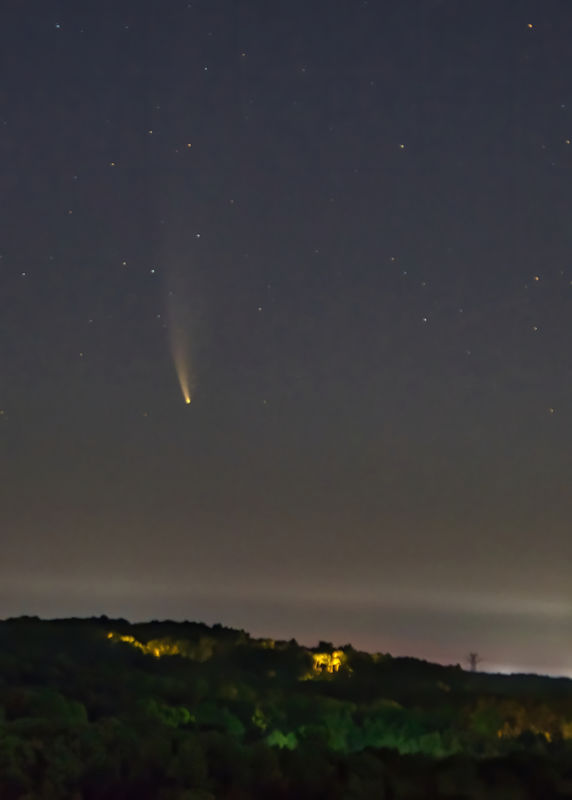Comet question
Jul 15, 2020 17:06:50 #
I am going out tonight to try and get some shots. Do I take my 18-200 and get the wide view like I see in a lot of photos or do I take my 120-400 to zoom in?
Jul 15, 2020 17:10:12 #
If you want to actually see the comet, the longer the lens the better. Shoot on a tripod with VR off.
Jul 15, 2020 17:11:02 #
Um, why not both and experiment to see what you like better???
Jul 15, 2020 17:12:25 #
Longshadow wrote:
Will it be visible long enough to switch lenses?Um, why not both and experiment to see what you like better???
Oh wait, the longer lens goes down to 120 mm, plenty wide enough; otherwise, it'll be just a tiny speck, right? Take the super-zoom!
Jul 15, 2020 17:15:54 #
Linda From Maine wrote:
Will it be visible long enough to switch lenses?
...
...
Beats me!
I believe the sight duration is limited by the comet's declination for one's location and the rotation of the earth.
It's not like the comet will zip out of range.
HOW visible will depend on the intensity of any city afterglow.
Jul 15, 2020 17:47:45 #
larryepage
Loc: North Texas area
MWojton wrote:
I am going out tonight to try and get some shots. Do I take my 18-200 and get the wide view like I see in a lot of photos or do I take my 120-400 to zoom in?
The last documentation that I saw indicated that the brightness of the comet is about the same as a Magnitude 1 star. This is pretty bright, but photographing the comet is going to be pretty similar to other night sky photography. Depending on the time and the amount of light remaining in the sky, you are going to want to use ISOs somewhere between 2,000 and 4,000, apertures close to f/2.8, and exposures of 15-30 seconds. So I would go with the fastest lens you have available. Remember that as you use a longer lens, you will have to reduce exposure time in order to prevent motion blur. The rule of 500 is your guide (500/focal length to get maximum exposure time in seconds), although cheating a little is better than losing an opportunity.
Remember...manual focus and manual exposure. Use Live View and zoom (if available) to help with focus, or take some kids and send them out 300 or 400 feet with a flashlight to set focus.
I hope you can have good luck tonight. Despite the oppressive heat, clouds have prevented any sort of opportunity to get a photograph here in the North Texas area.
Jul 15, 2020 18:20:52 #
Longshadow wrote:
Um, why not both and experiment to see what you like better???
I thought of that.
Jul 16, 2020 08:01:38 #
billnikon
Loc: Pennsylvania/Ohio/Florida/Maui/Oregon/Vermont
MWojton wrote:
I am going out tonight to try and get some shots. Do I take my 18-200 and get the wide view like I see in a lot of photos or do I take my 120-400 to zoom in?
120-400
Jul 16, 2020 08:16:00 #
Sidwalkastronomy
Loc: New Jersey Shore
I photographed the comet on Sunday before sunrise. I was on very light polluted area on the boardwalk looking over ocean
street lights right behind me.
got my starting point from my brother in Colorado from a dark sky location.
I'm going to disagree with using a longer length as the most spectacular part of the comet is its long tail and with luck you can see the tail split. The length of the tail is many times size of full moon.
Focus is tough. I would start with
135 mm iso 800 and 4 seconds. Next problem is locating it. I purposely way over exposure to see it the comet and move camera to position it. Remember comet is a white dot and tail very long so give yourself plenty of room by positioning comet off center. I use a canon 77D so I use the + 5x 10x to see focus and position. When you position it and properly focus I would vary the time longer or shorter. Iso is last thing I would adjust because you're getting more noise. The 500 rule is good but sometimes you compromise and ill deal with minor star trailing and better camera shot of the tail. My best was iso 800 f 5 @2 sec. 135 mm.
street lights right behind me.
got my starting point from my brother in Colorado from a dark sky location.
I'm going to disagree with using a longer length as the most spectacular part of the comet is its long tail and with luck you can see the tail split. The length of the tail is many times size of full moon.
Focus is tough. I would start with
135 mm iso 800 and 4 seconds. Next problem is locating it. I purposely way over exposure to see it the comet and move camera to position it. Remember comet is a white dot and tail very long so give yourself plenty of room by positioning comet off center. I use a canon 77D so I use the + 5x 10x to see focus and position. When you position it and properly focus I would vary the time longer or shorter. Iso is last thing I would adjust because you're getting more noise. The 500 rule is good but sometimes you compromise and ill deal with minor star trailing and better camera shot of the tail. My best was iso 800 f 5 @2 sec. 135 mm.
Jul 16, 2020 08:16:05 #
MWojton wrote:
I am going out tonight to try and get some shots. Do I take my 18-200 and get the wide view like I see in a lot of photos or do I take my 120-400 to zoom in?
I think your picture is going to need/want some context. I too intended to take some "close-ups" of the comet. I took my Tamron 18-400 on my Canon 80D. Most of my good pictures were shot wide. The attached photo was 44mm, F4.5, ISO 2000, 13 second exposure. (Auto WB, VC off, manual focus). However, the picture is somewhat deceiving! I was not able to see the comet like this! All I saw was a smudge in the sky. It was only as I let the light gather in the camera that the comet revealed itself. I was quite surprised when I saw the first exposure reveal what my eye could not see!
The "close-ups" I tried to take were pretty useless. Again, without context it's hard to know what you're seeing. The majesty of the event is lost. In fact, trying to find the comet in the sky, zoomed in was surprisingly difficult!
I'm just an amateur photographer who didn't want to miss a once in a lifetime event! I got up at 2:30am, drove to and climbed a local ski mountain, and then experimented with various settings. My shooting window was about two hours until sunrise. The comet fades very fast with the first hint of sun. It was a wonderful and fun reason to miss sleep! I hope to get out again at a more scenic setting to try to capture it again!
Jul 16, 2020 08:28:06 #
Sidwalkastronomy
Loc: New Jersey Shore
I photographed the comet on Sunday before sunrise. I was on very light polluted area on the boardwalk looking over ocean
street lights right behind me.
got my starting point from my brother in Colorado from a dark sky location.
I'm going to disagree with using a longer length as the most spectacular part of the comet is its long tail and with luck you can see the tail split. The length of the tail is many times size of full moon.
Focus is tough. I would start with
135 mm iso 800 and 4 seconds. Next problem is locating it. I purposely way over exposure to see it the comet and move camera to position it. Remember comet is a white dot and tail very long so give yourself plenty of room by positioning comet off center. I use a canon 77D so I use the + 5x 10x to see focus and position. When you position it and properly focus I would vary the time longer or shorter. Iso is last thing I would adjust because you're getting more noise. The 500 rule is good but sometimes you compromise and ill deal with minor star trailing and better camera shot of the tail. My best was iso 800 f 5 @2 sec. 135 mm.
street lights right behind me.
got my starting point from my brother in Colorado from a dark sky location.
I'm going to disagree with using a longer length as the most spectacular part of the comet is its long tail and with luck you can see the tail split. The length of the tail is many times size of full moon.
Focus is tough. I would start with
135 mm iso 800 and 4 seconds. Next problem is locating it. I purposely way over exposure to see it the comet and move camera to position it. Remember comet is a white dot and tail very long so give yourself plenty of room by positioning comet off center. I use a canon 77D so I use the + 5x 10x to see focus and position. When you position it and properly focus I would vary the time longer or shorter. Iso is last thing I would adjust because you're getting more noise. The 500 rule is good but sometimes you compromise and ill deal with minor star trailing and better camera shot of the tail. My best was iso 800 f 5 @2 sec. 135 mm.
Jul 16, 2020 08:28:42 #
Jul 16, 2020 08:30:31 #
Sidwalkastronomy
Loc: New Jersey Shore
here is my attempt 800 iso f 5
2 sec. I shoot raw as I'm new at post processing
2 sec. I shoot raw as I'm new at post processing
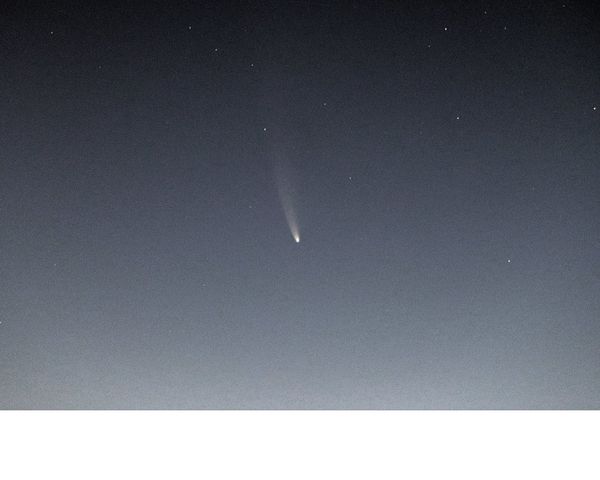
Jul 16, 2020 08:49:07 #
MWojton wrote:
I am going out tonight to try and get some shots. Do I take my 18-200 and get the wide view like I see in a lot of photos or do I take my 120-400 to zoom in?
Don't limit yourself. With the comet being in the northeast sky, you being in PA puts you closer to it than a friend of mine who shot it from here in CO using a 600mm lens and got about what everyone else is getting, the horizon and a very small image of the comet up high given the overall size of the total picture. I haven't been out to shoot this comet yet but back in 1997 when Hale-Bopp came through from the street in my Denver suburb it was barely visible until I went up on Mt Evans outside of Denver to about the 12,000 ft level and it looked a lot bigger so, while I know you don't have any 12,000 ft peaks to work from, if you have some nearby high spots there it might pay to go up to shoot. When I went up on Mt. Evans, I took a 500mm lens to shoot what was a mere spot in the sky from 5,300 ft. and at 12,000 ft I had to settle on a 28-80 zoom at about 65mm to get the framing I wanted so it can be kinda tricky. March 26, 1997, still with several feet of snow, it was cold at 12,000 ft and my camera kept freezing up in the middle of the second exposure so I'd have to take it off the tripod and get in the car with the heater on and in a couple of minutes you'd hear the mirror drop in my Nikon FA. I shot the image below with 100asa film wide open at f/2.8 for 25 seconds, just a tad too long. The dirty white stuff at the bottom of the picture is the snow on top of the Continental Divide. If I get out to shoot this current comet, I'll have much better equipment with more reach and won't be throwing fifty rolls of film at it plus processing. It should feel a lot better and be more fun.
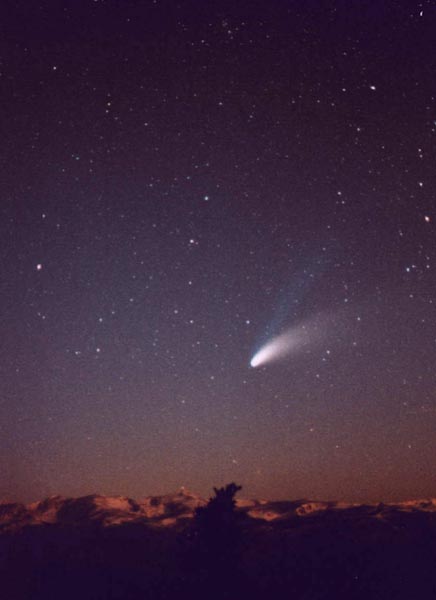
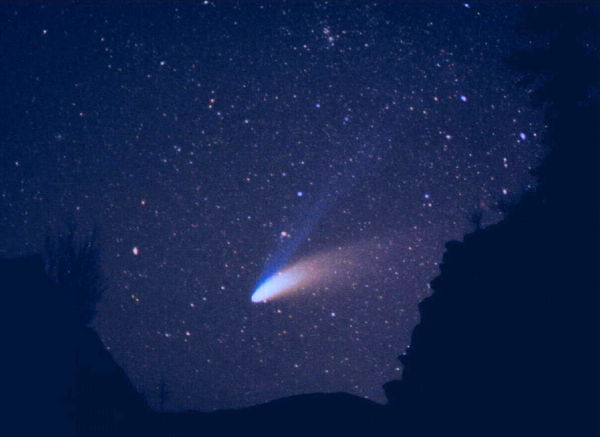
Jul 16, 2020 10:15:44 #
Shot last night before 9 PM mountain time with a 70-300 zoom lens on a crop Nikon. I preset the camera to F 4.5, 4 sec, ISO 3200, on a tripod with VR off. Low in the NW sky in central AZ. Got 3 shots and it dropped below the horizon. It will be higher in the sky as days pass. First located it with 10X50 binocs.
Good luck!
Good luck!
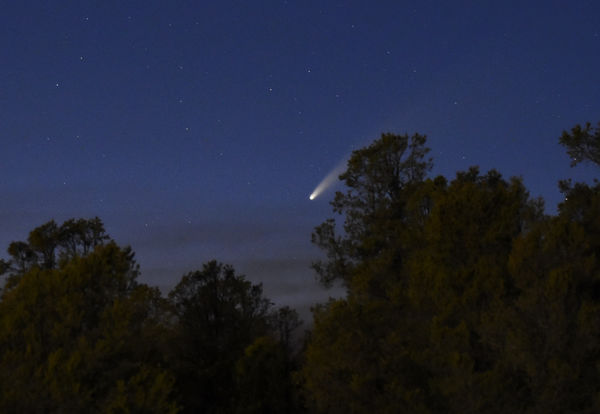
If you want to reply, then register here. Registration is free and your account is created instantly, so you can post right away.




